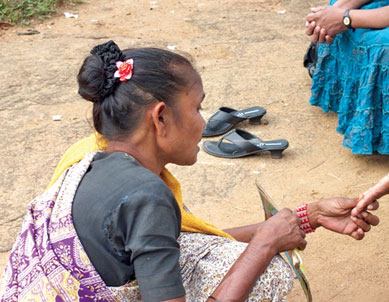Variga Sabha unites all communities
The people in Sri Lanka are divided into ethnic groups. The four
major ethnic groups are the Sinhala, Tamil, Muslims and Burghers and
there are other minority ethnic groups such as Veddahs and Gypsies.
The Sri Lankan Nomads, gypsies known as Ahikuntika are a minority
community slowly disappearing in their numbers. Threatened by the change
and technology advancements, many find it hard to fit into the common
culture even though some of them have successfully integrated into the
mainstream society, resulting in a drastic change in their traditional
lifestyle and customs.The Gypsies are believed to be the descendants of
North Indian Telungu people. They are conversant in Tamil, Sinhala and
Telungu.
 The Gypsies are a forgotten community. In most cases there are no
records of them, such as birth, marriage death and address. Therefore,
they were not given the opportunity to enjoy most of the basic human
rights, including the right to vote in the past.Gypsies are a minority
community living peacefully, surrounded by nature moving from place to
place. Their traditional means of living are snake charming and fortune
telling. The Gypsies are a forgotten community. In most cases there are no
records of them, such as birth, marriage death and address. Therefore,
they were not given the opportunity to enjoy most of the basic human
rights, including the right to vote in the past.Gypsies are a minority
community living peacefully, surrounded by nature moving from place to
place. Their traditional means of living are snake charming and fortune
telling.
Heritage
The gypsy community has a rich cultural and historic heritage and a
value system.
In the recent past there had been a few initiatives to improve their
lifestyle, but this does not suffice to fully cater to their welfare.
Although they still depend on their traditional livelihood, permanent
settlements have also been used by this group.
Their uniqueness has to be preserved whilst enhancing their
livelihoods. To facilitate this Dilmah Conservation in collaboration
with the University of Colombo carried out a comprehensive study on the
socio economic aspects of the Ahikuntika Community.
It was done as part of Dilmah's Cultural and Indigenous Communities
Program.
The nomadic community in Sri Lanka was able to hold a tribal meeting
or Variga Sabha for the first time in six decades with the support of
Dilmah Conservation.
The event took place on the banks of the Rajangana Tank in Kudagama,
Thambuttegama in 2011. Gypsies from all corners of Sri Lanka met as one
community and spoke to each other about their lives, changing times,
concerns and the need to preserve their unique identity disappearing in
the face of modernization.
Following the first Variga Sabha after an interval of over 60 years,
and subsequent discussions with the Ahikuntika Community, Dilmah
Conservation undertook to support the preservation of this unique
community's cultural identity.
As part of this efforts, the Ahikuntika Cultural Centre and People's
Theatre worth Rs. 15 million was set up in Kudagama by Dilmah
Conservation in collaboration with the Divisional Secretariat
Thambuttegama.
It has an open air theatre and a museum to house traditional arts and
crafts. The design and construction of the Centre is done by the
Department of Architecture , University of Moratuwa.
The Ahikuntika Variga Sabha
The Variga Sabha brought together five community leaders to one
platform where they discussed the problems they faced. The leaders made
a pledge to unite to strengthen and save their cultural identity.
The first Charter of the Ahikuntika community, the ' Kudagama Charter
of the Sri Lankan Ahikuntika Community' was brought forward endorsed by
the five community leaders on behalf of their communities.
This is regarded as a landmark event not only for a minority
community in the country but also for the worldwide gypsy community at
large. |

